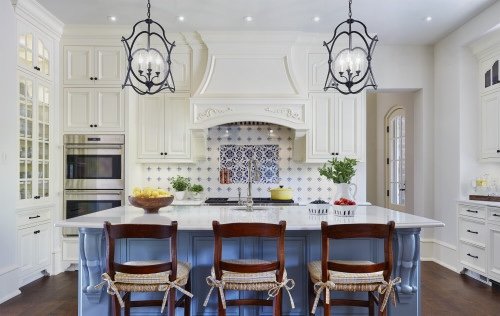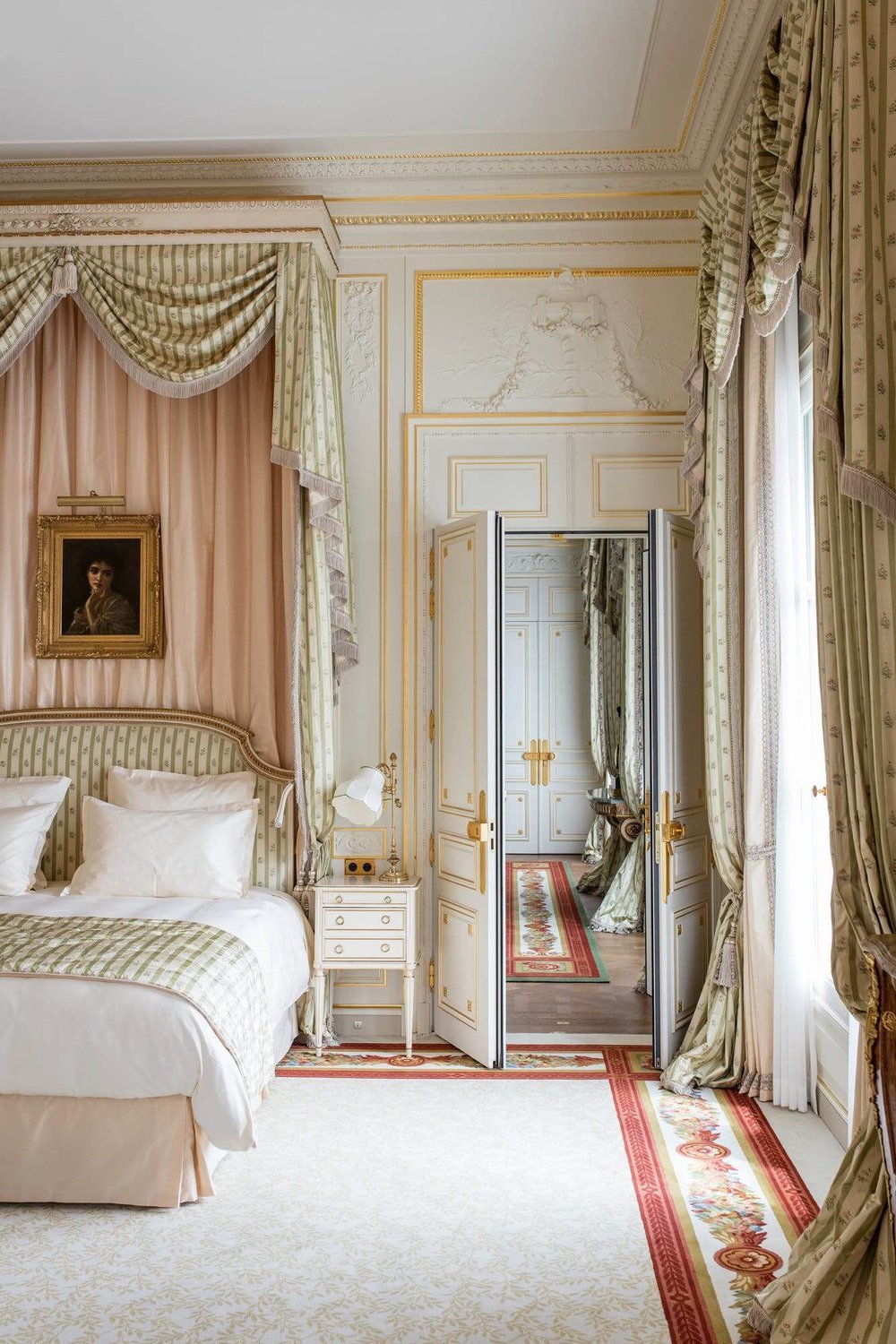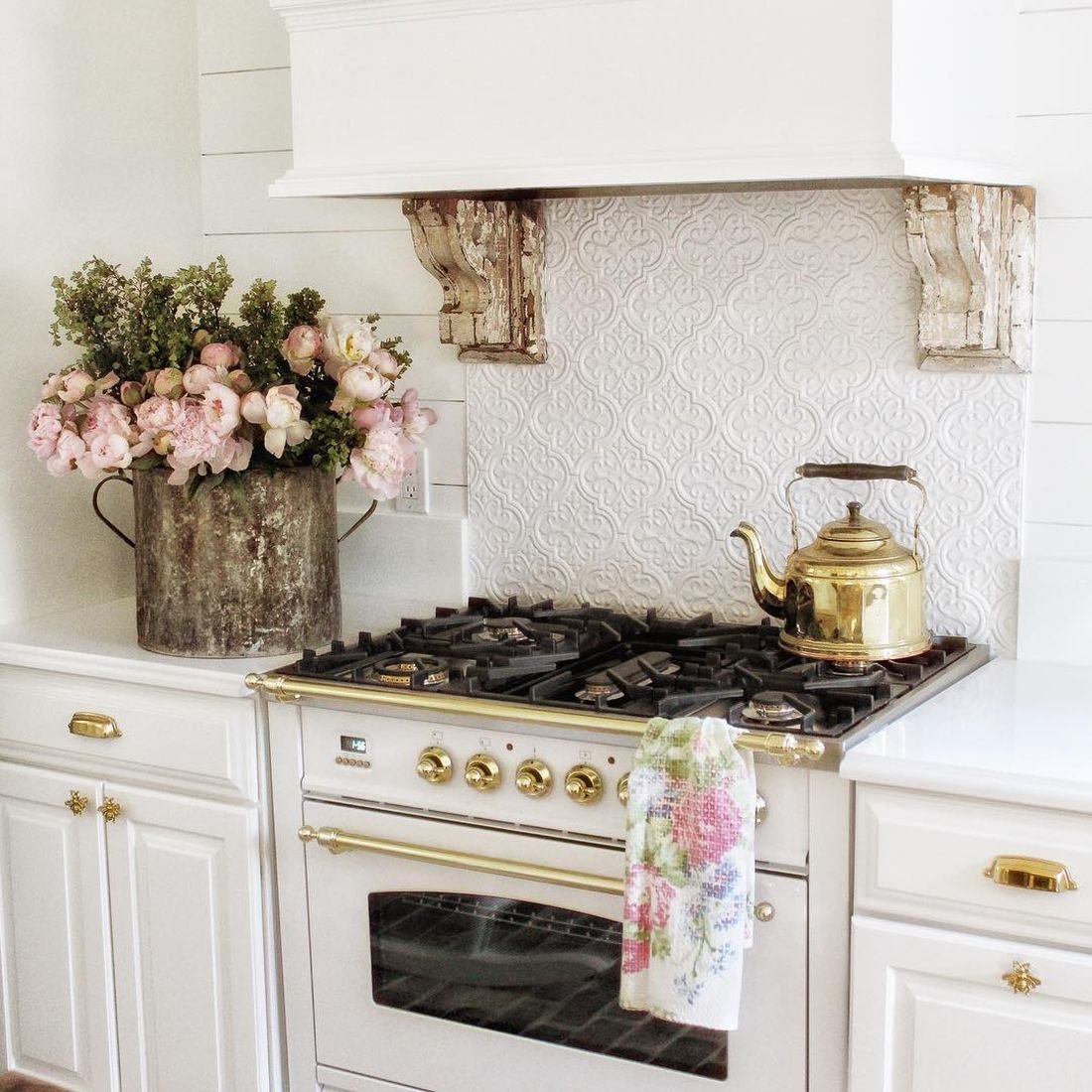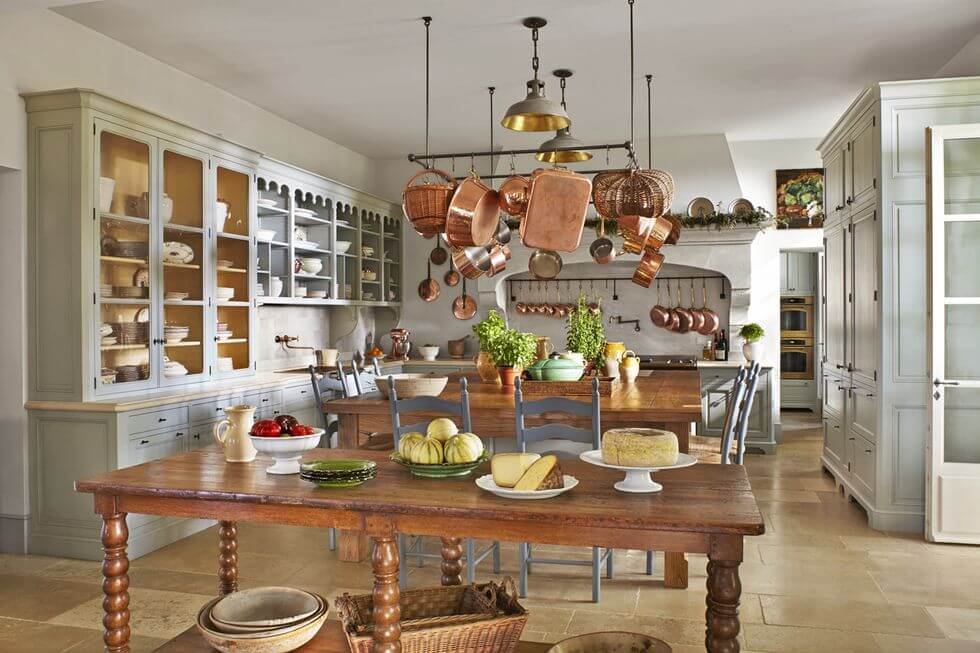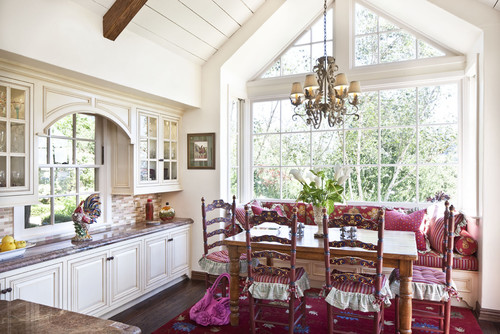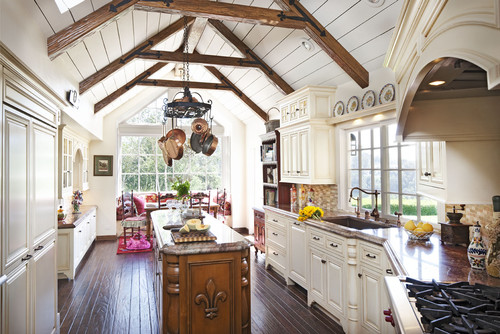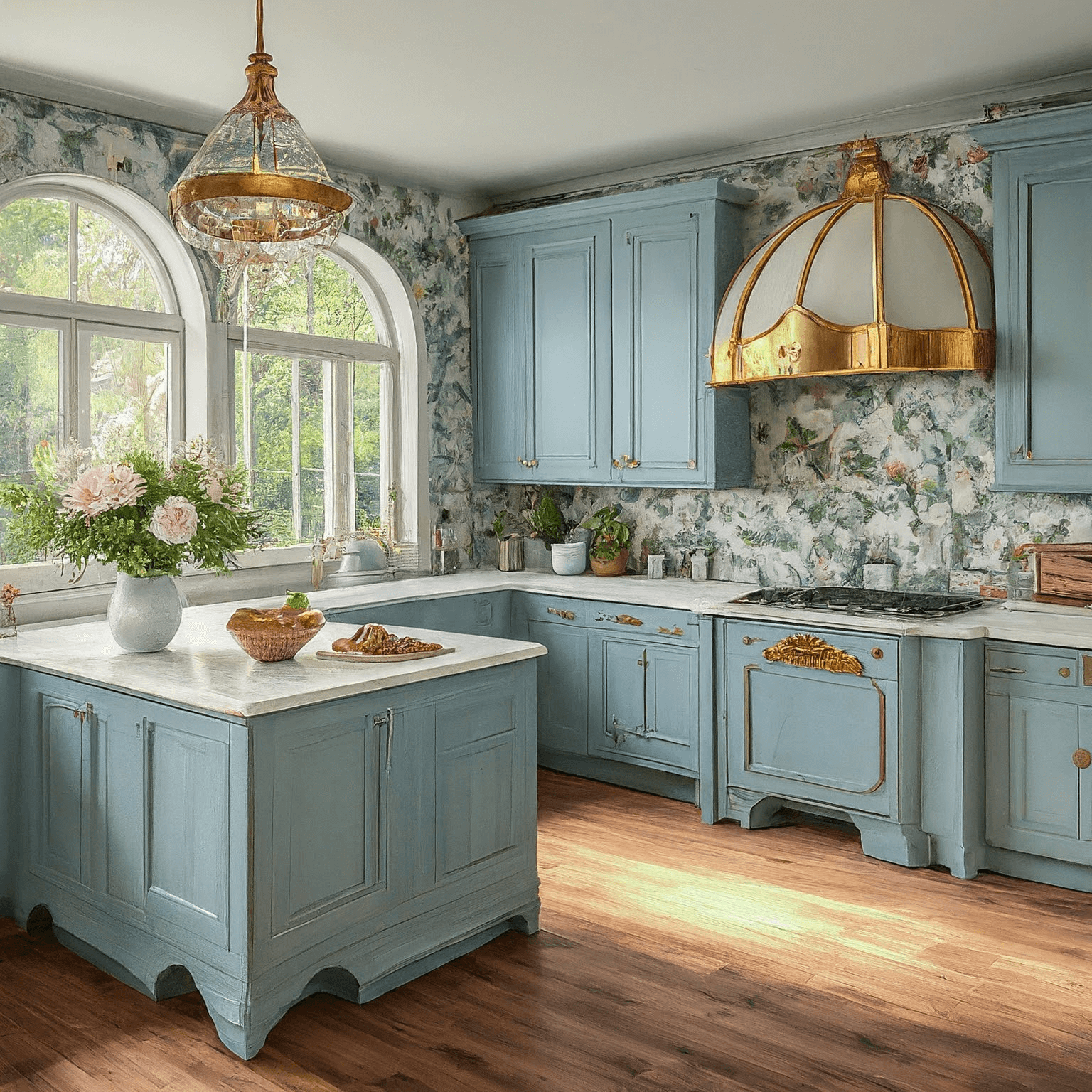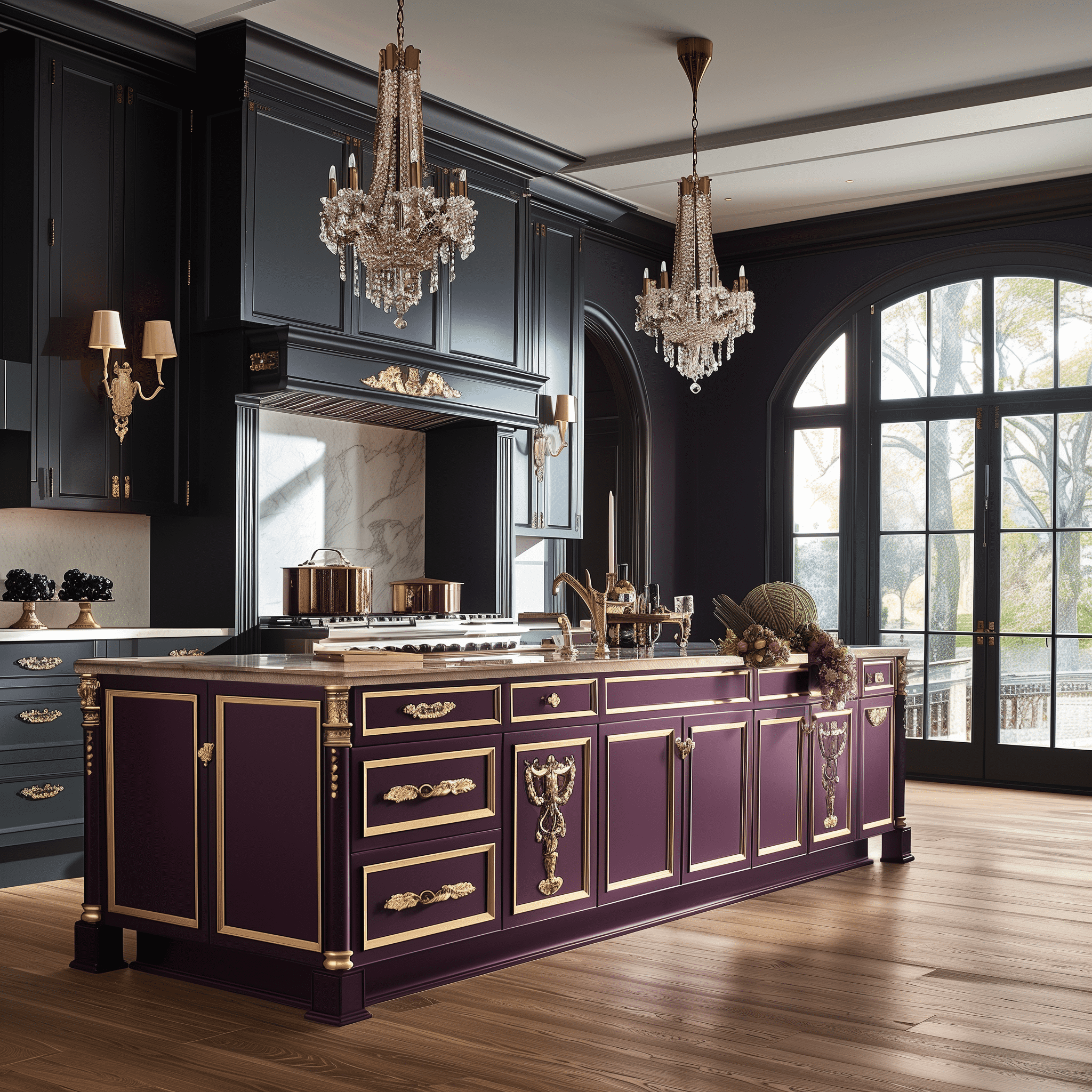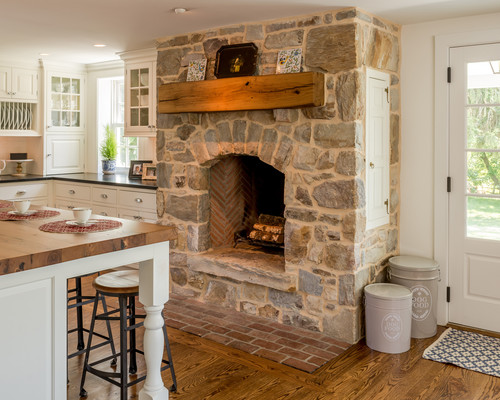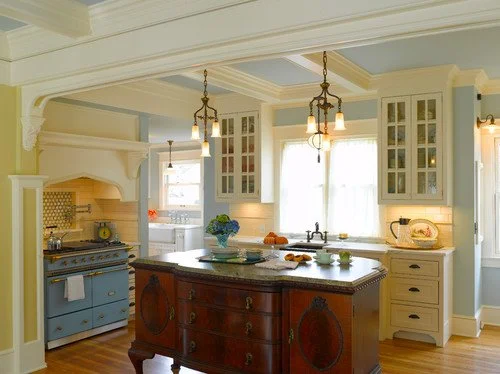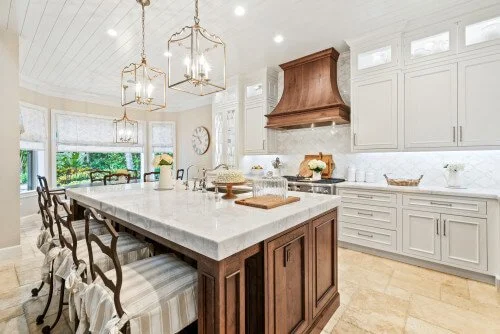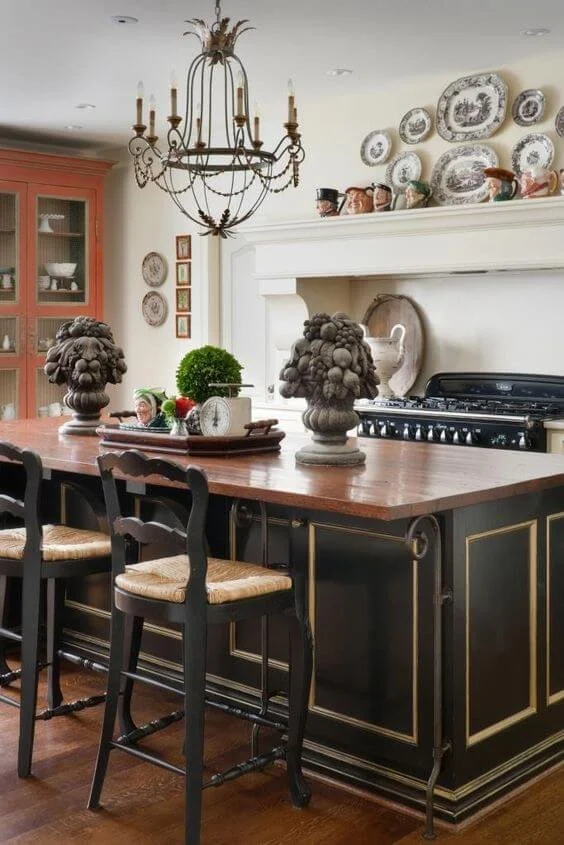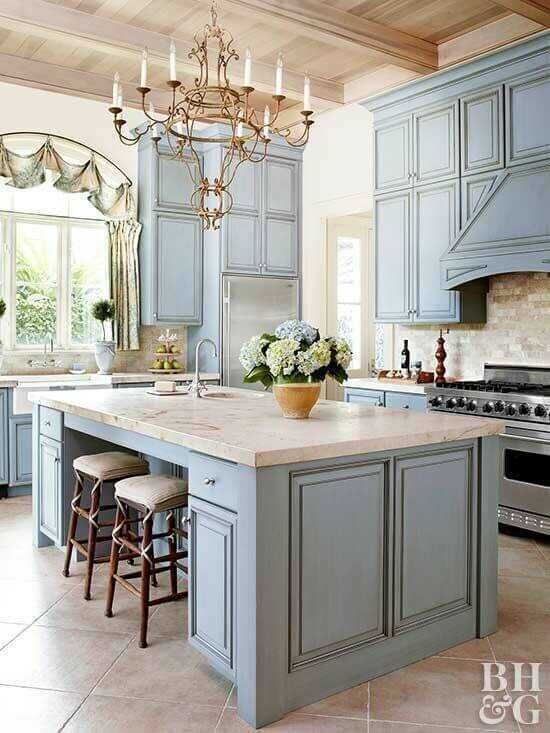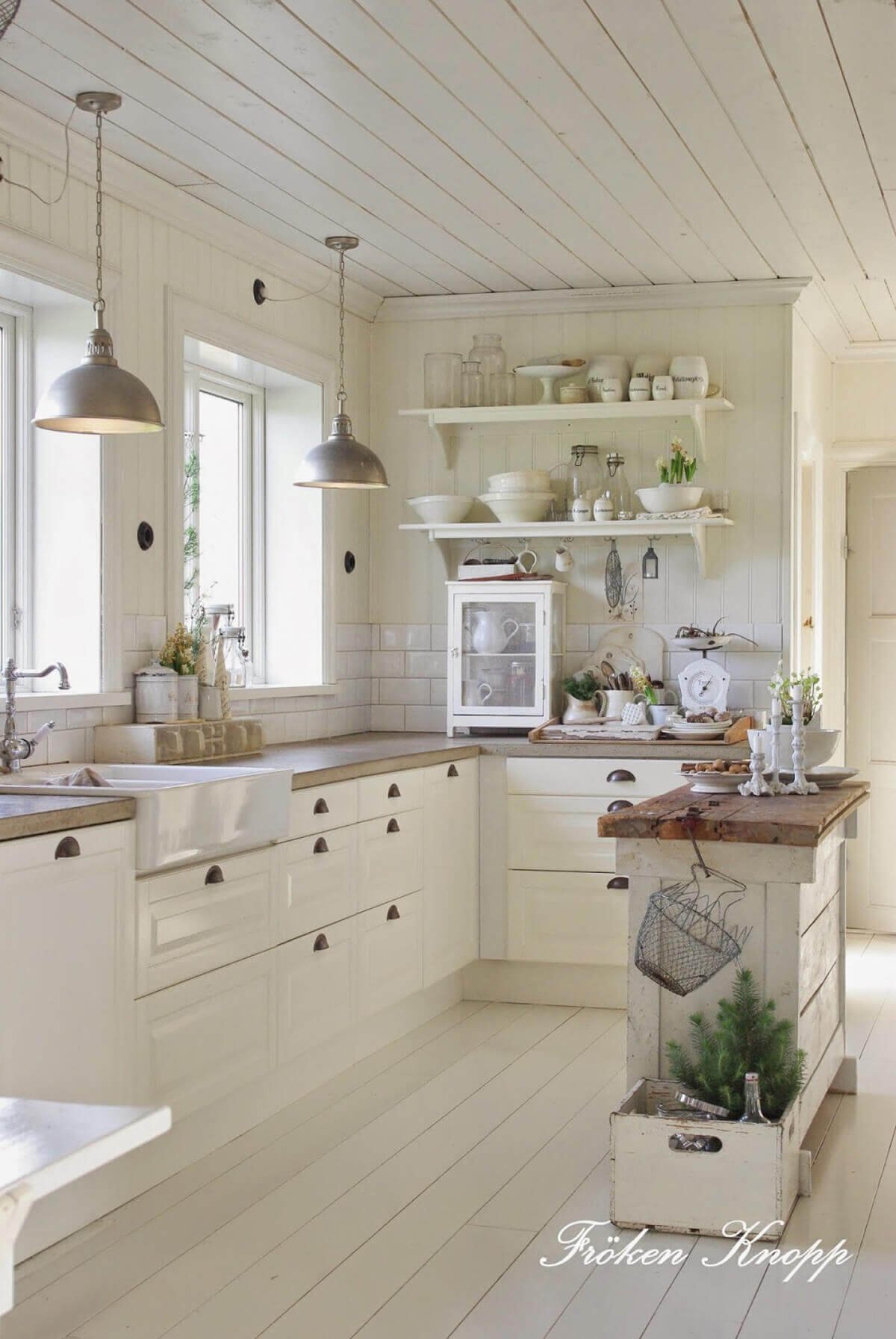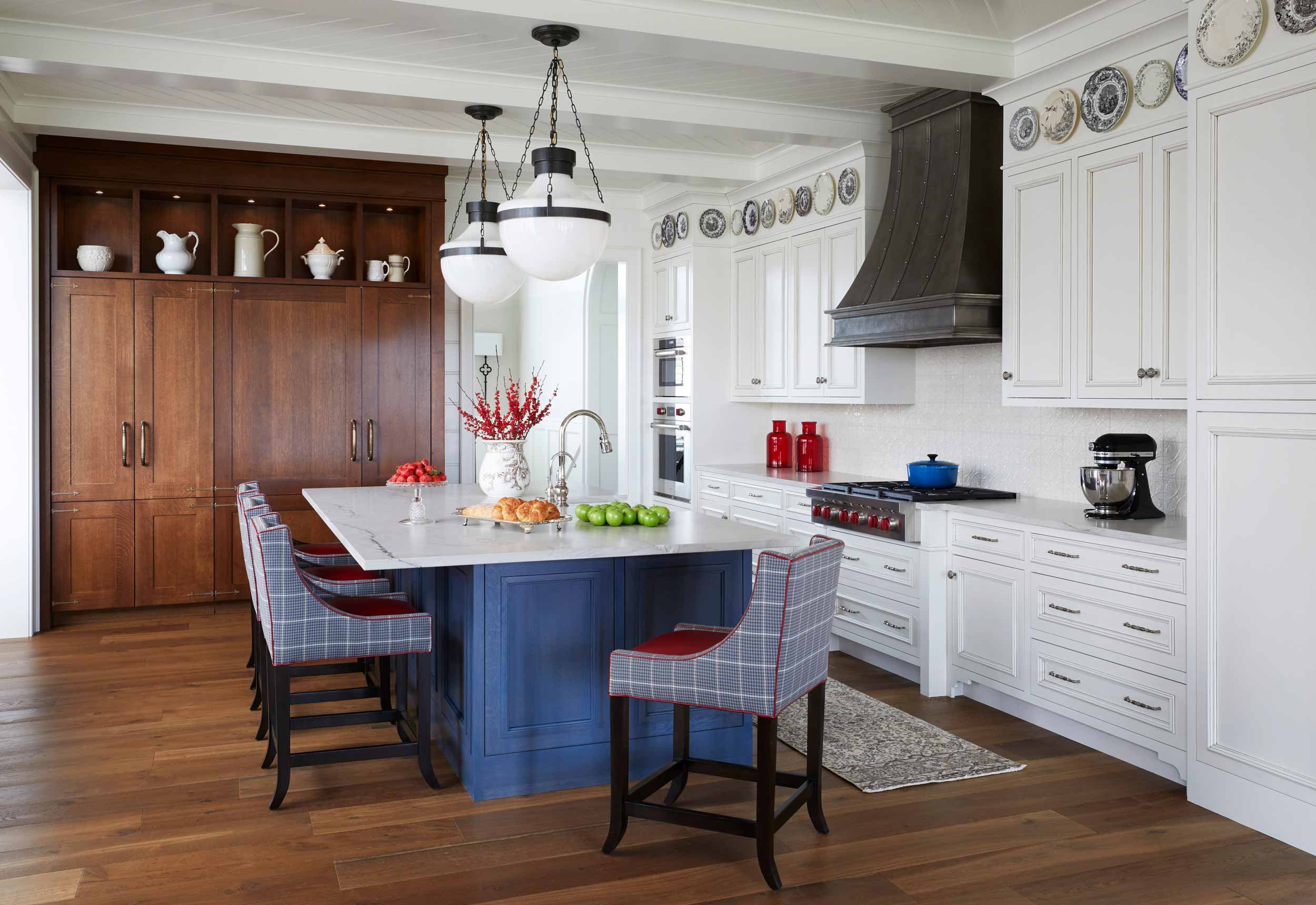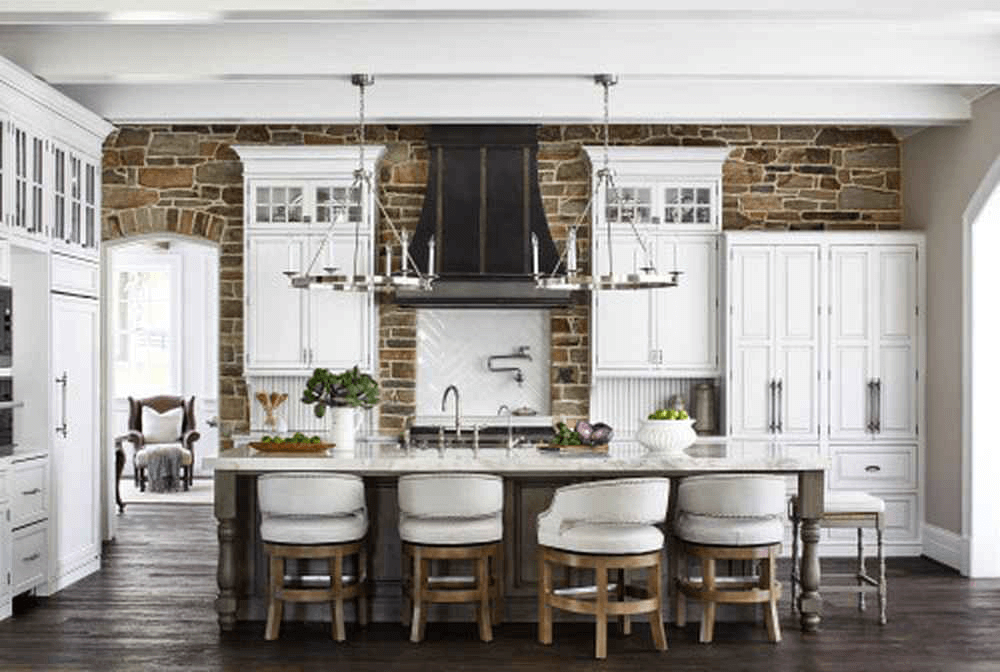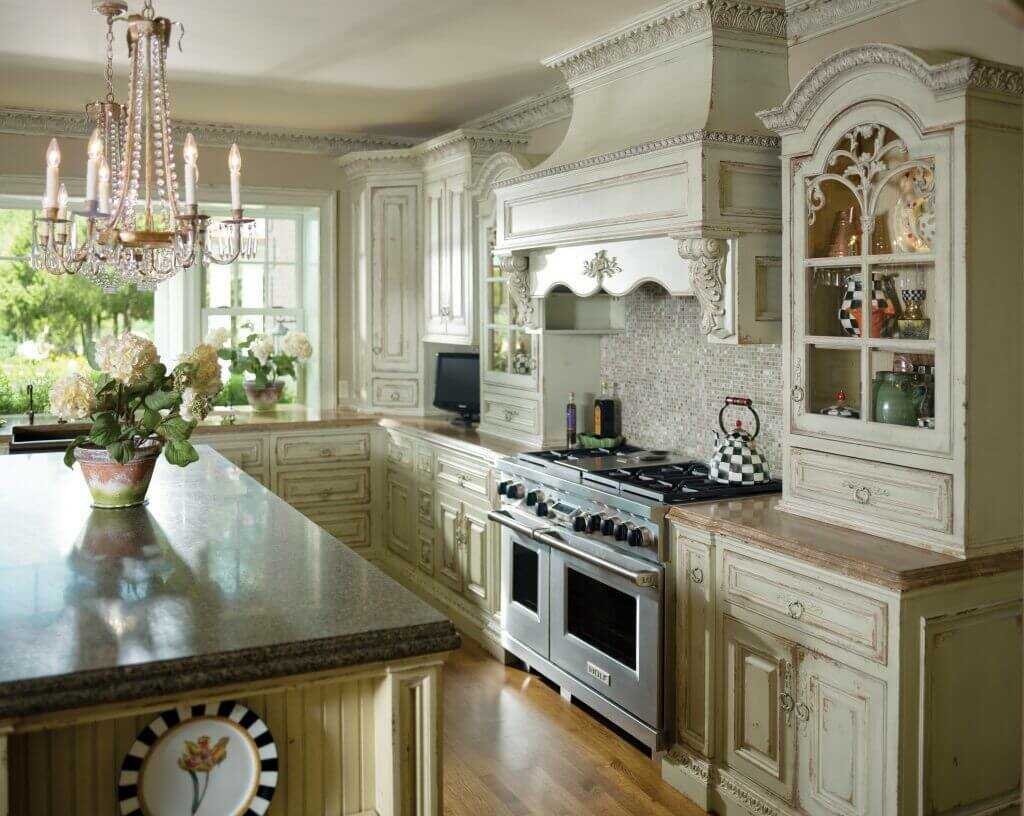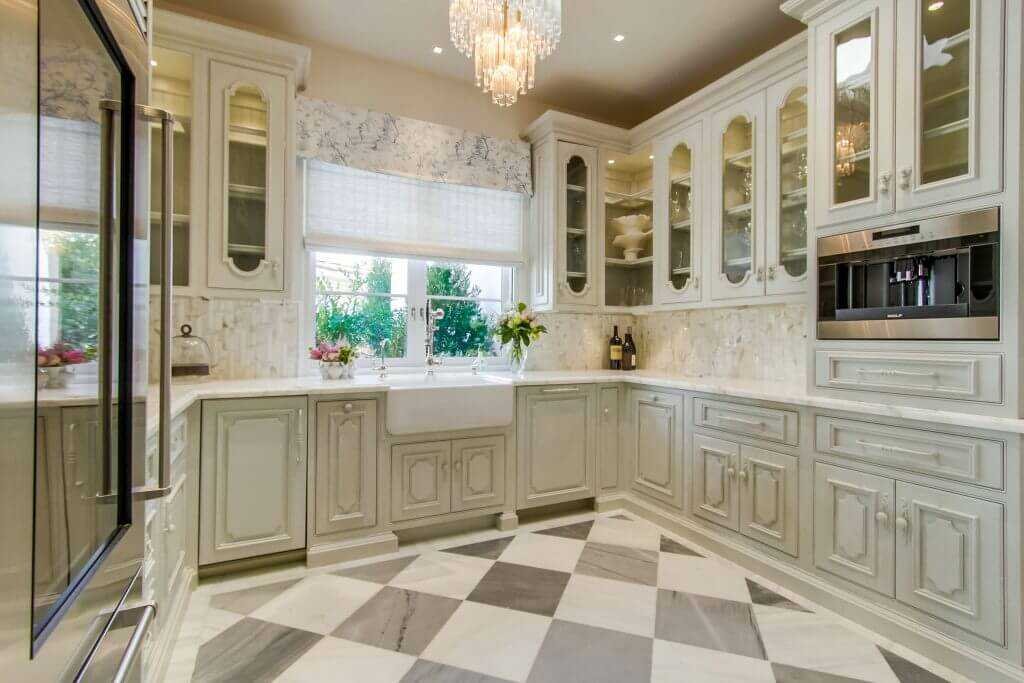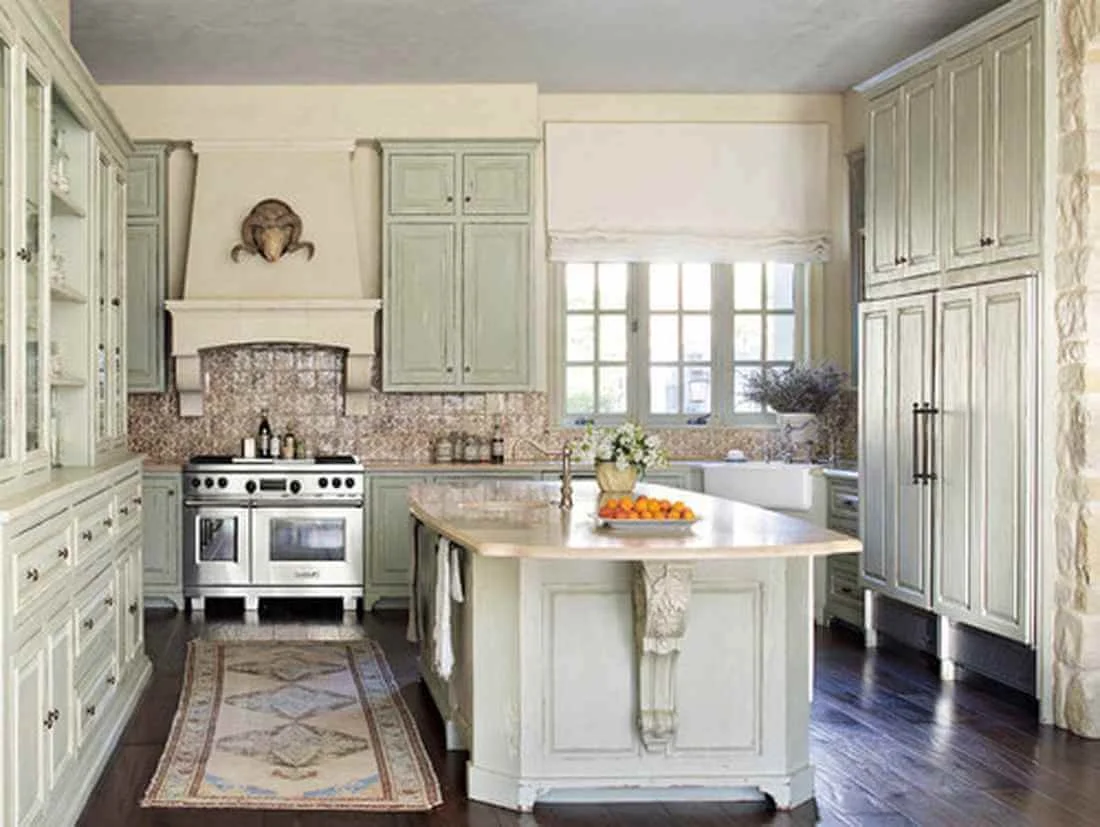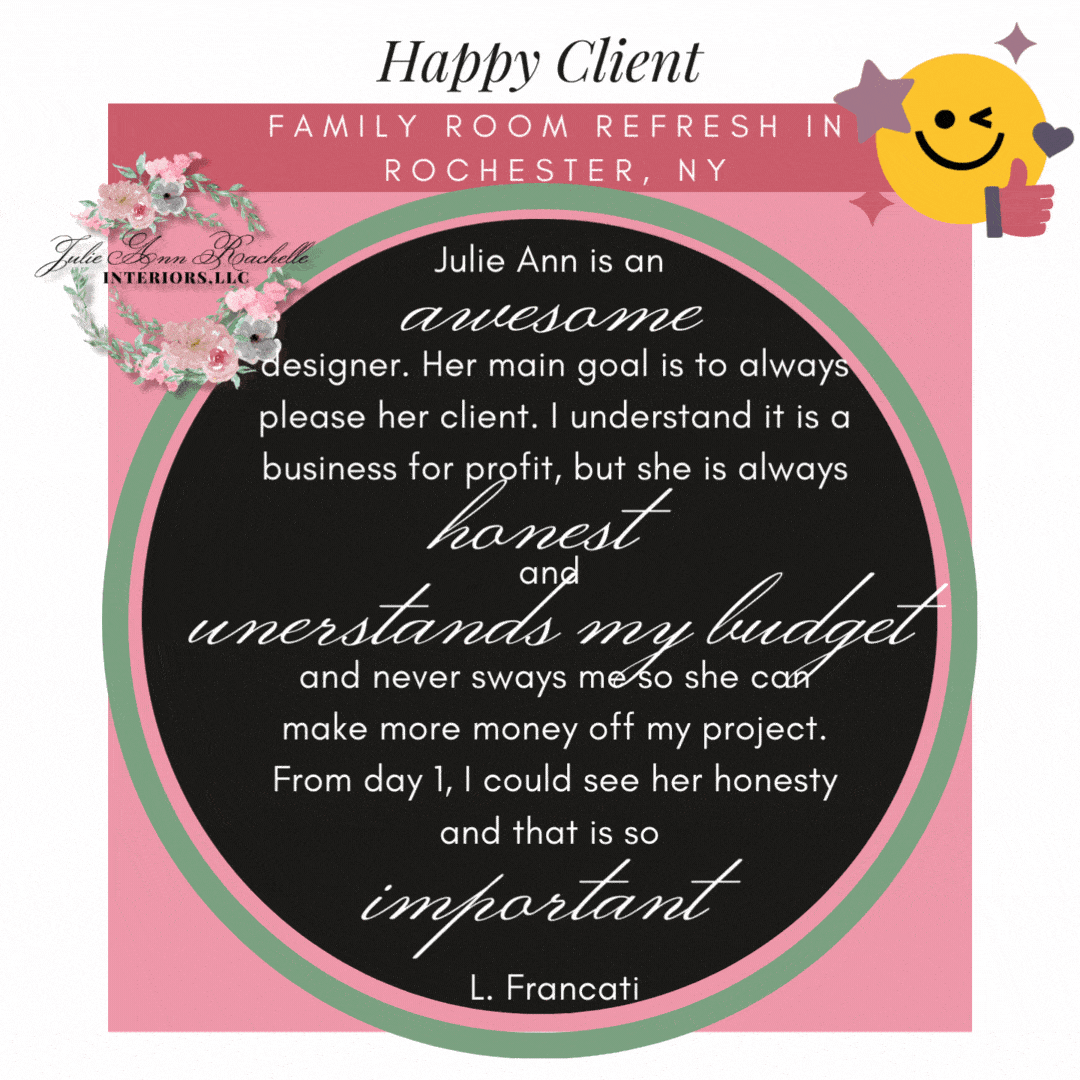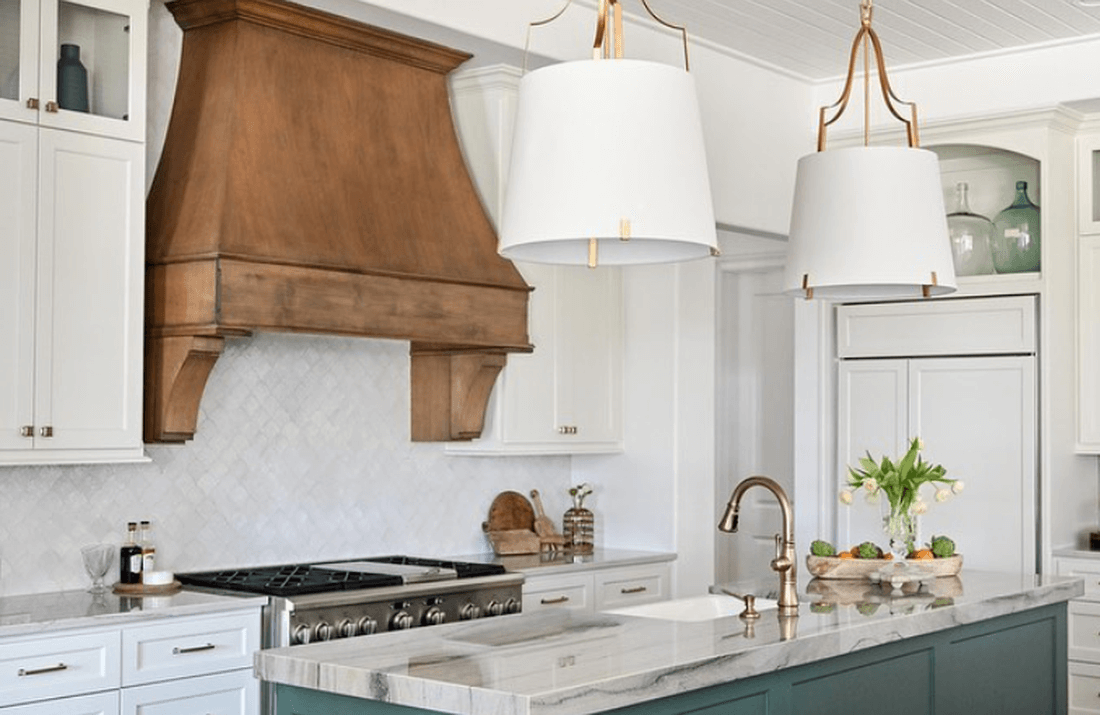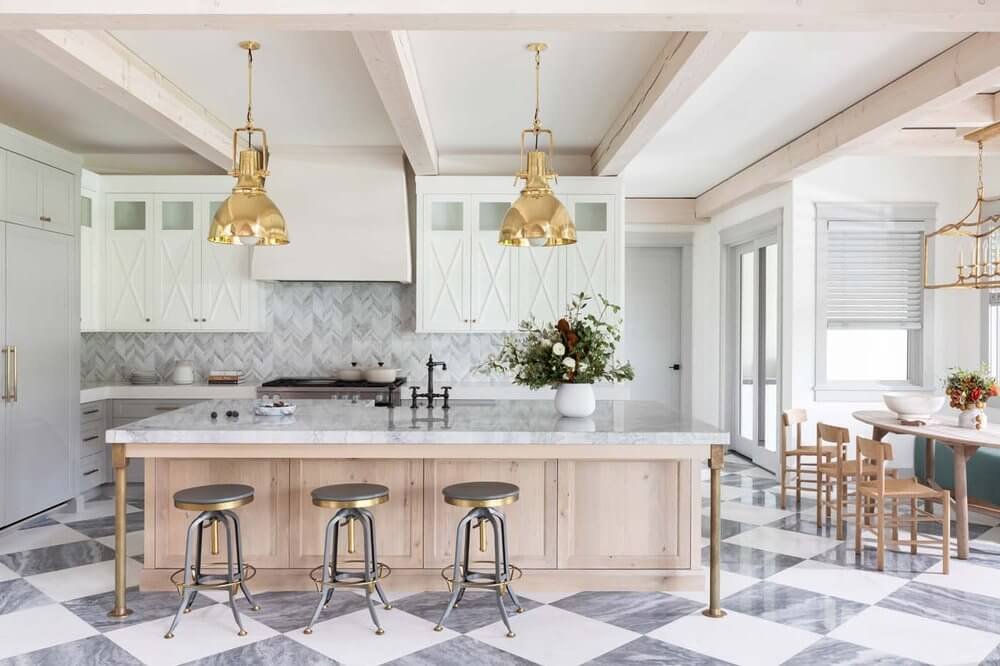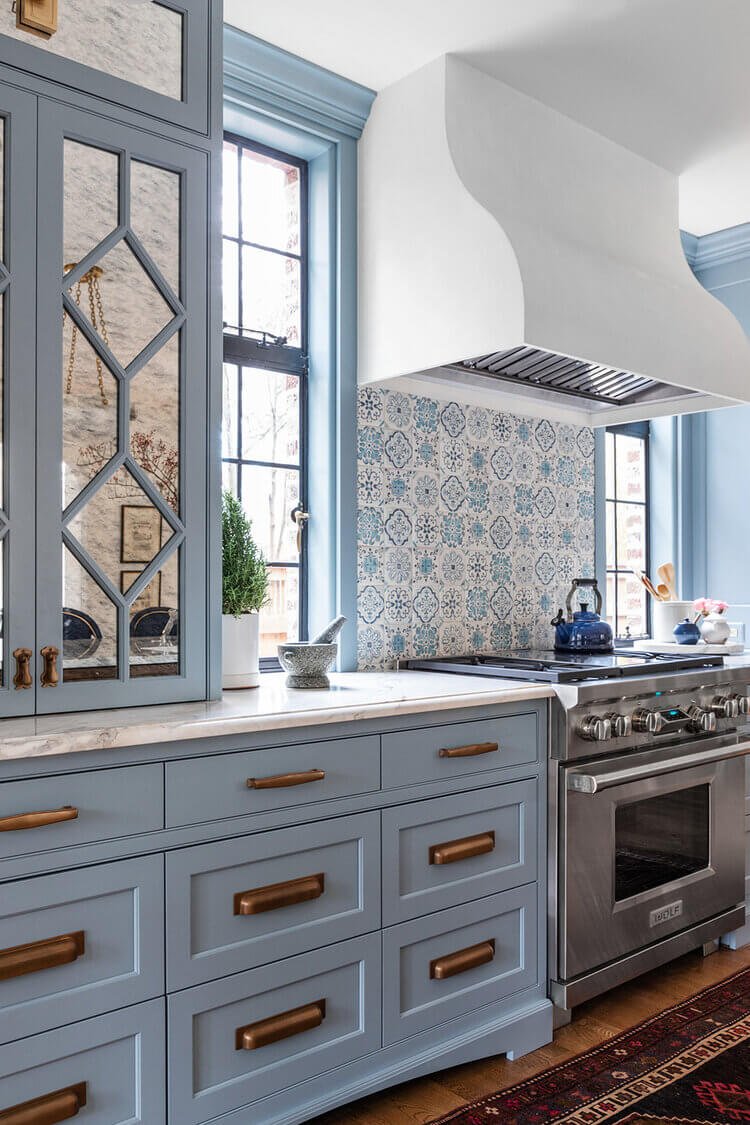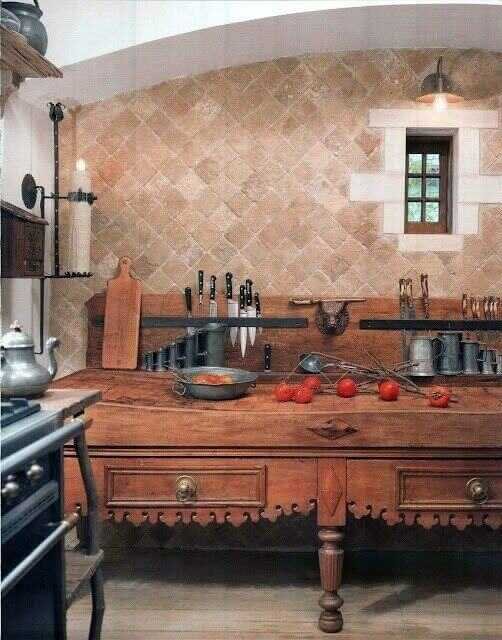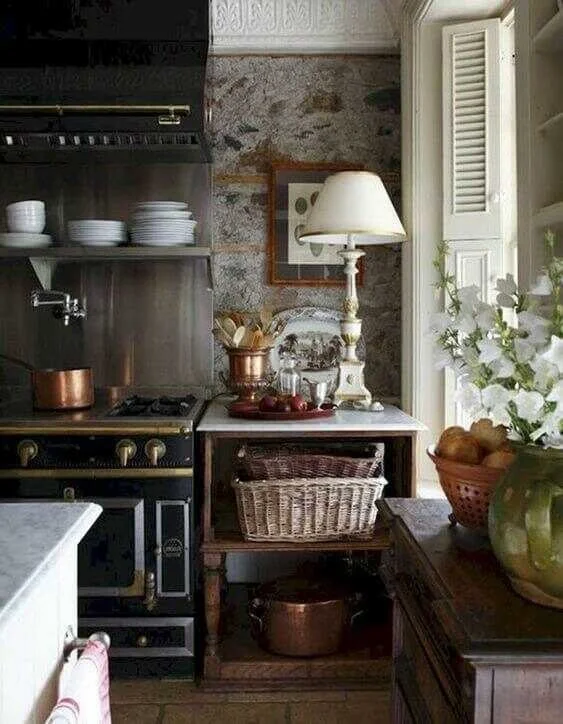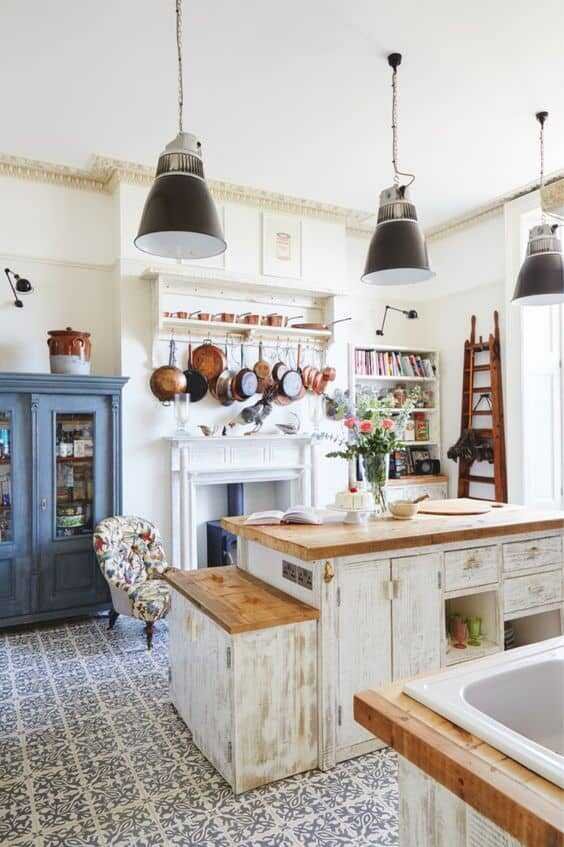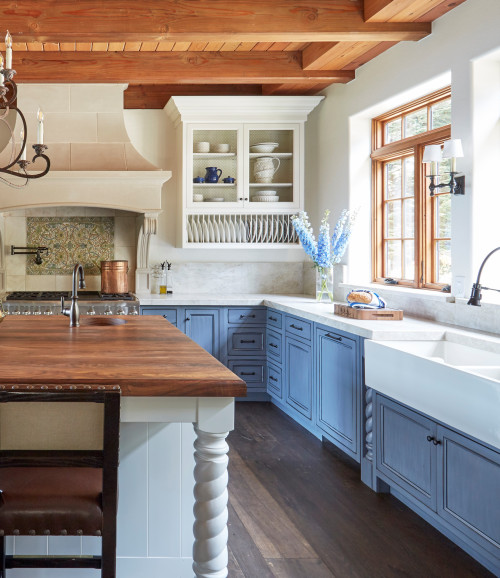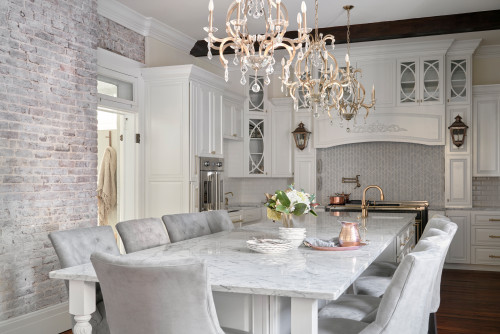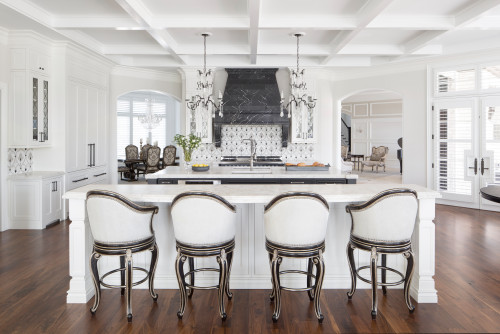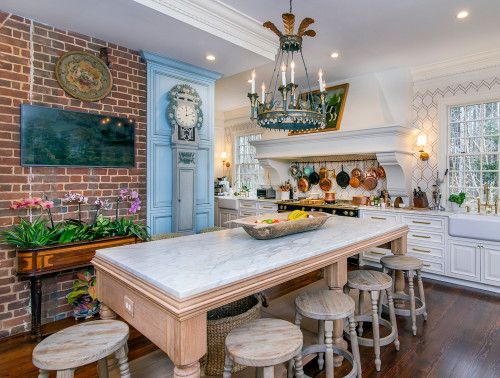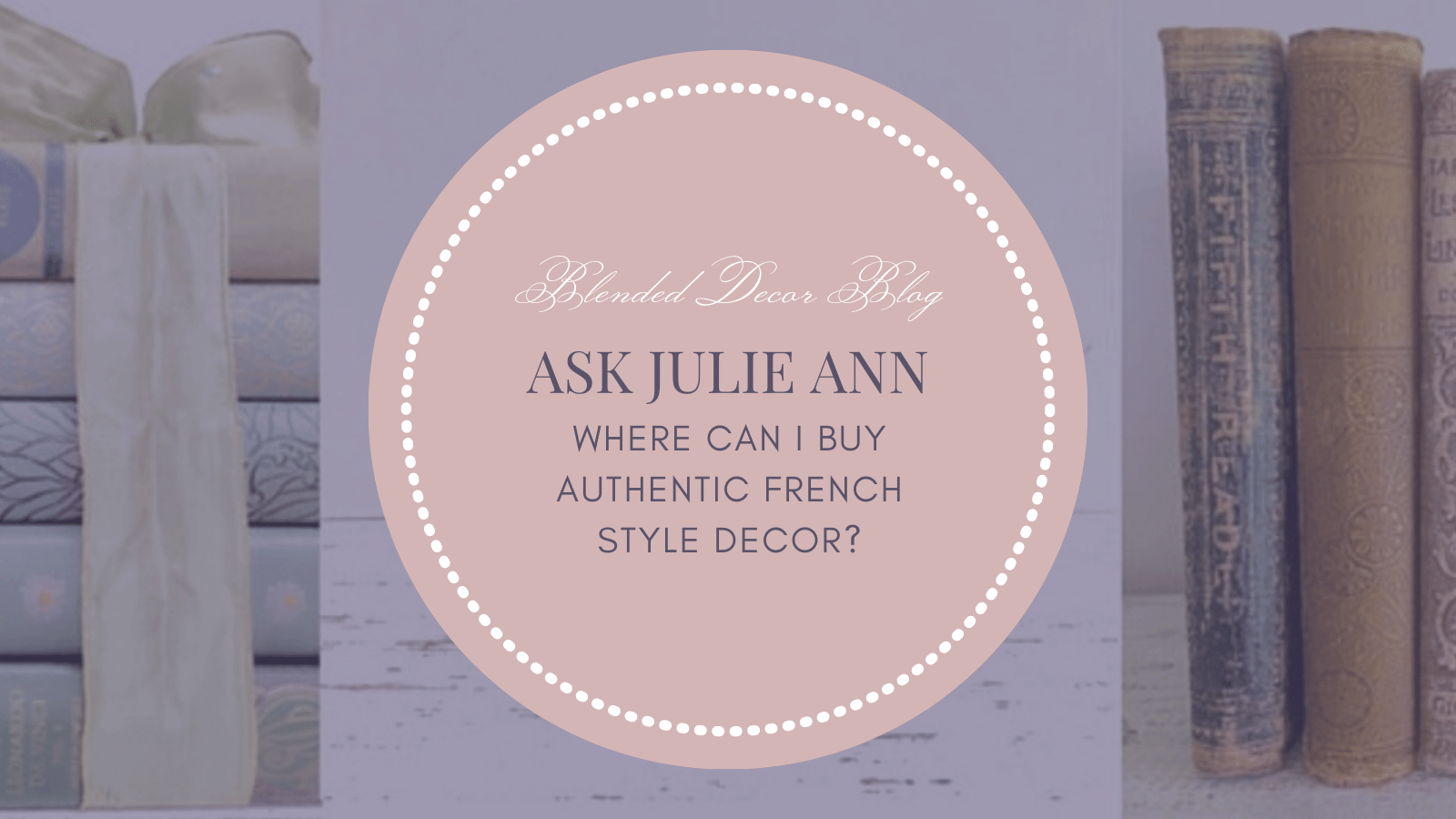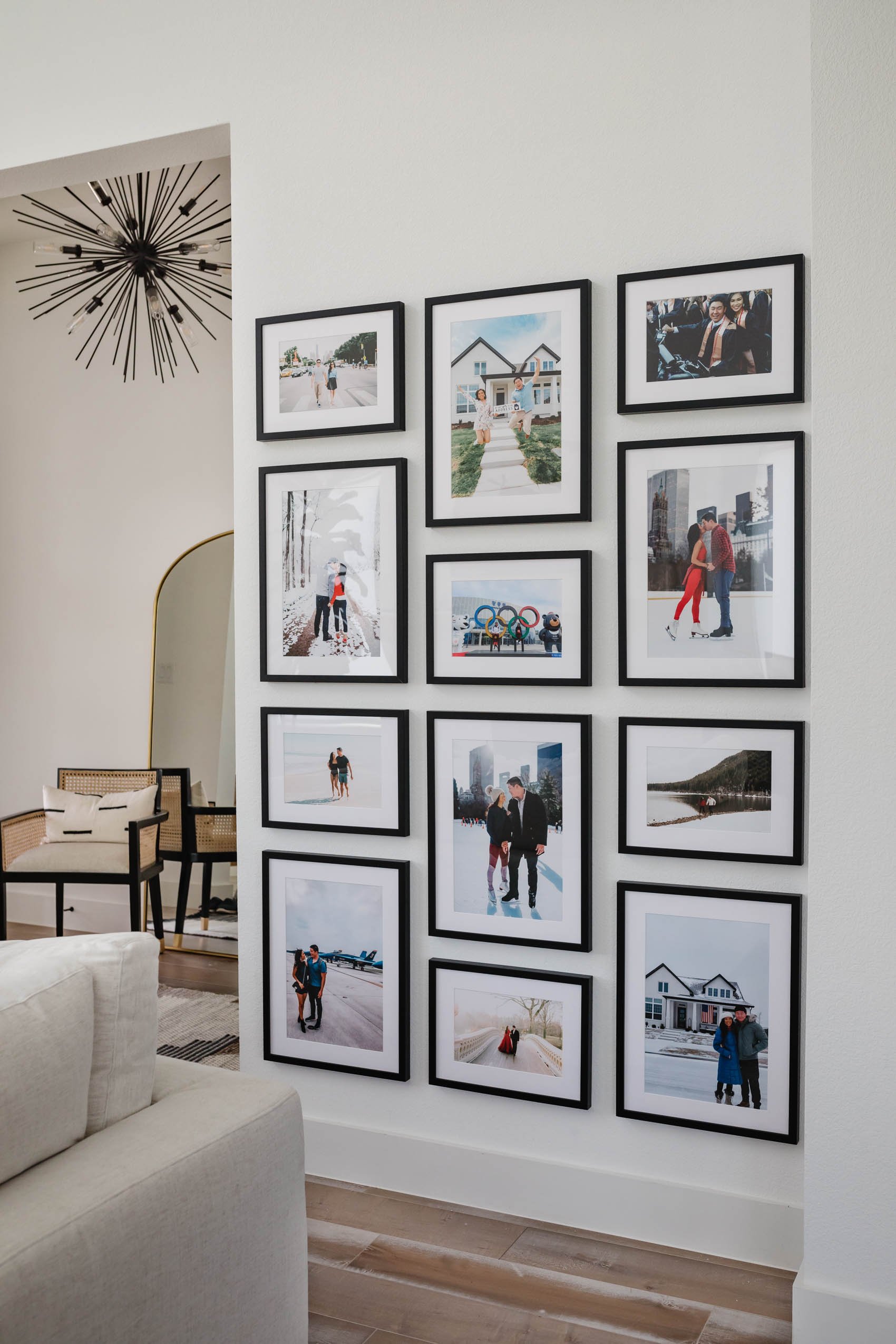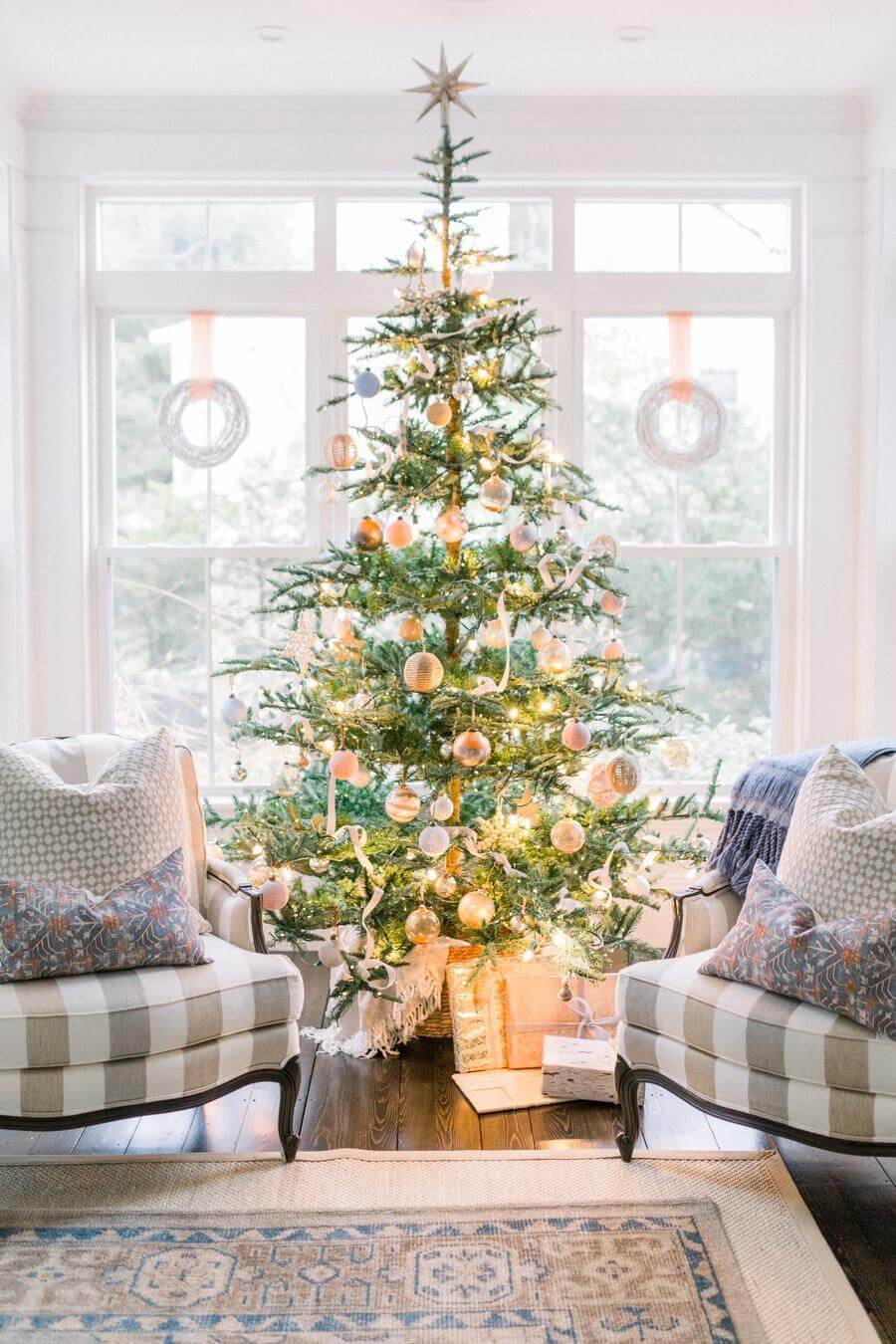How to Achieve a French Country Kitchen Feel
Blended Decor Blog
French Country Kitchen Decor Ideas to Inspire You
French Country Estate Kitchen, Corey Gaffer, Photography | Martha O’Hara Interiors, Interior Design & Photo Styling
Embracing the captivating essence of French country kitchen design not only presents a harmonious fusion of style and convenience but also grants an effortless canvas for creative adornment.
Through the enchantment of picturesque imagery and uncomplicated inspirations, an effortless kitchen transformation awaits.
Whether your inclination leans towards a traditional ambiance reminiscent of the French countryside or a more contemporary interpretation, this insightful discourse will artfully guide you through the process.
Embark on an exploratory journey that unveils quintessential elements of French country design, enabling you to infuse your kitchen with a timeless allure.
Furthermore, delve into an array of decorative elements, meticulously chosen to personalize your interior space.
Allow yourself to be transported as we embark on a mesmerizing quest to curate your dream French country kitchen, a testament to your refined taste and unwavering vision.
This article contains commissionable links. Affiliate disclosure policy.
I have recently updated this article with the assistance of Gemini Google AI.
Related Reading:
Table of Contents
Photo via @simplyfrenchmarket
What kind of lighting goes in a French Country style kitchen?
Comments: Please let me know if you enjoyed this article and if you have any questions.
Real French farmhouse in Provence designed by Susan Bednar Long, photographed by Alexandre Bailhachei; featured on Veranda.com
What is a French Country Style Kitchen?
A French Country style kitchen represents an exquisite manifestation of France's rustic allure and pastoral charisma.
Renowned for its warm, earthy color palette and harmonious use of natural materials like wood and stone, this design aesthetic beautifully intertwines with ornate embellishments, such as captivating ceramic tiles in vibrant hues and vintage-inspired accents.
Drawing inspiration from the esteemed French Baroque, Rococo, Empire, and Provincial styles, this distinct approach to kitchen design showcases notable features like exposed beams, embracing the spirit of authenticity, and open shelving, offering both functionality and visual appeal.
Farmhouse-style sinks further enhance the ambiance, evoking a sense of nostalgia and embracing traditional charm.
By integrating elements from various French design eras, a French Country style kitchen effortlessly cultivates an enchanting and hospitable atmosphere, gracefully resonating with the very essence of the idyllic French countryside.
A French Country Style kitchen is one that embraces one or more french styles of design, such as:
A French Country Style kitchen embraces one or more exquisite French design styles, including the opulent and influential French Baroque period that spanned from 1610 to 1774.
During this era, marked by the reigns of three powerful French kings, a sense of extravagance and prosperity permeated the land.
White River via
Paris and Versailles became global destinations, drawing visitors who sought to immerse themselves in the grandeur of Baroque-style architecture and artistic expressions.
The monarchy's immense power and abundant resources fueled a period of expressive artistry and awe-inspiring creativity.
Under the reign of Louis XIII, the French Baroque period was ignited, as he expanded the Louvre Palace and extended unprecedented patronage to the arts.
However, it was Louis XIV who truly solidified the era's opulence.
Seeking to surpass his predecessors, he commissioned the construction of grand châteaux at Versailles, becoming a beacon of grandeur.
Additionally, he supported and nurtured some of France's most talented artists.
Louis XV continued the aesthetics of the Baroque period, although the lavishness began to wane due to resource depletion, ultimately leading to the French Revolution in 1789.
The French Baroque period holds immense historical significance for numerous reasons.
It witnessed a flourishing of French art, architecture, and culture that influenced other European nations of the time.
This era's hallmark is its opulent and heavily adorned style, a testament to the wealth and authority of the monarchy. While the excesses eventually contributed to social upheaval, they also served as inspiration for some of the most remarkable artistic works in history.
Even today, the French Baroque period remains a vital element of French culture and history, with its profound influence discernible in various contemporary artistic creations.
FRENCH BAROQUE KEY ELEMENTS
Period: 1610-1774 (reigns of Louis XIII, Louis XIV, and Louis XV)
Origin:
Direct influence from Italian Baroque: Sharing core principles like theatricality, movement, and light-shadow contrasts.
Unique Features of French Baroque:
Royal Patronage: Unlike the decentralized nature of Italian Baroque, French Baroque was heavily influenced by the patronage of powerful monarchs, especially Louis XIV. This led to a focus on grandeur, order, and symmetry to reflect the King's authority and power.
Classical Influence: French artists and architects also drew inspiration from classical Greek and Roman art, resulting in a more restrained and rational approach compared to the exuberance of Italian Baroque. This is evident in the use of geometric forms, columns, and domes in French architecture.
National Identity: While incorporating Italian and classical elements, French artists also sought to create a distinct national style, showcasing French craftsmanship and elegance. This is seen in the development of unique decorative motifs and the use of French materials like marble and tapestry.
Characteristics:
Architecture: Grandiose, ornate, with dramatic curves, columns, and sculptures.
Art: Paintings and sculptures characterized by intense drama, movement, and light-shadow contrasts.
Overall: A bold, expressive style that pushes boundaries and evokes emotions.
MODERN FRENCH BAROQUE KITCHEN CHARACTERISTICS:
SHOP THE LOOK
A French Baroque kitchen designed today wouldn't be an exact replica of a 17th-18th century kitchen, but rather a modern interpretation that captures the essence of the style while incorporating modern functionality.
Here are some key characteristics:
Color Palette:
Rich and opulent: Deep jewel tones like emerald green, sapphire blue, burgundy, and even black can be used for cabinetry, walls, or accents.
White for balance: While dark colors are prominent, white is often used to balance them out and create a sense of airiness. This can be through painted cabinetry, countertops, or even tile backsplashes.
Metallic accents: Gold, silver, and brass add a touch of luxury and grandeur. These can be incorporated through hardware, lighting fixtures, decorative elements, or even appliances.
Materials:
Natural and luxurious: Wood is a dominant material, often in rich mahogany, walnut, or cherry with intricate carvings and decorative moldings.
Marble and other stones: Countertops, backsplashes, and even flooring can be made from marble, granite, or other elegant stones for a timeless feel.
Fabrics: Rich fabrics like velvet, silk, and damask can be used for upholstery, window treatments, or even chair cushions, adding a touch of opulence.
Design Elements:
Curves and movement: Unlike modern kitchens with straight lines, French Baroque embraces curves and organic shapes. This can be seen in the cabinet shapes, countertops, and even decorative elements.
Ornate details: Carvings, swags, and other decorative elements are key to the Baroque style. These can be incorporated on cabinets, furniture, and even lighting fixtures.
Symmetry and grandeur: The overall layout should be symmetrical and balanced, with a sense of grandeur and formality. This can be achieved through a central island, a fireplace, or even a large chandelier.
Modern touches:
Functionality: While embracing the style, modern kitchens need to be functional. Integrate high-end appliances, smart storage solutions, and ergonomic layouts seamlessly.
Lighting: Combine opulent chandeliers with modern recessed lighting for optimal illumination and ambiance.
Personalization: Don't be afraid to add your own personal touch to the design, whether it's through artwork, unique furniture pieces, or even pops of color.
Remember, the key is to capture the essence of French Baroque's grandeur and opulence while ensuring the kitchen remains functional and reflects your personal style in a modern setting.
While French Rococo heavily influenced interior design and architecture throughout grand French homes, it's important to remember that kitchens during this period existed in a different world.
Typically, they were:
Separate and utilitarian spaces: Unlike the integrated and open kitchens of today, Rococo kitchens were often located away from the main living quarters, often in basements or outbuildings. Their primary purpose was food preparation and storage, not entertaining or socializing.
Not decorated in the full Rococo style: Due to their utilitarian function and distance from the main living areas, kitchens rarely received the same level of decorative attention as dining rooms or salons.
However, some Rococo elements might be present:
Color palette: Lighter colors like pale green, cream, or pale yellow, reflecting the overall Rococo preference for light and airy spaces.
Accents: Elements like curved cabinet doors, floral motifs on tiles or fabrics, or gilded hardware could be used sparingly.
Materials: While not as opulent as in other areas, kitchens might utilize high-quality wood for cabinetry, copper pots for cooking, and tin-glazed earthenware for storage.
Additionally:
Open shelves: Instead of closed cabinets, open shelves were often used to display cookware and utensils.
Brick ovens and hearths: Wood-fired brick ovens or hearths were the primary means of cooking.
Limited appliances: Aside from basic tools like knives and mortars, appliances were scarce.
Overall:
While the extravagant flourishes and playful spirit of Rococo might be found in subtle details, French Rococo kitchens remained primarily functional spaces. Their focus was on practicality, not aesthetics.
If you're looking for a Rococo-inspired kitchen today:
You can incorporate elements like:
light color palette
curved lines
floral motifs
Remember, the essence of Rococo lies not just in the ornamentation but also in its celebration of light, playfulness, and elegance, which can be translated into a contemporary setting.
Image courtesy of Toptenrealestatedeals.com via
The 18th century French Rococo period is one of the best-known eras of artistic style, renowned for its elegant, ornamental designs and distinctive pastel hues.
Though it came about during the 1720s and 30s, the Rococo style was not created by architects, but instead by craftspeople and designers—especially those who worked on furniture, silver, and ceramics.
This means the Rococo period had an enduring impact on culture, fashion, and interior design.
The Rococo period is often seen as a golden age of art and design, as work from that time is noted for its intricate detail and fanciful flourishes.
From the elaborate curves and scrollwork of the furniture to the bright, ebullient colors found in textiles and art, the Rococo era brought an element of grandeur to everyday life.
It was a period of opulence and beauty, and one that’s still influencing design today.
Rococo style pieces have become prized possessions among collectors.
From antique furniture to silverware and ceramics, these intricate items have a timeless quality and are steeped in art history.
As interior designer April Powers observes, “Rococo style is incredibly versatile, blending modern minimalism with the ornate aesthetic of the period. It can bring a sense of refined elegance to your home, especially if you accessorize with vintage pieces or custom-made furniture.”
But while the Rococo period is celebrated for its beauty and its influence, there’s an ethical and environmental cost to consider, too.
The production of Rococo-style pieces relied on the extensive use of natural resources, such as ivory and various woods, that are now scarce due to deforestation and climate change.
It’s important to be mindful of this when designing or decorating with pieces from this period, and to opt for sustainable alternatives where possible.
The 18th-century French Rococo period is a reminder of the power of art and design to shape a culture—as well as an important reminder of our responsibility as consumers.
As we continue to explore the beauty and impact of this masterpiece period, let’s do our part to preserve it, and ensure its legacy lives on for future generations. Source: V&M
French Rococo Key Elements
Period:
French Rococo is typically placed within the following period range: 1730 to 1774 (approximately)
However, it's important to note that there are some nuances to consider:
Overlapping periods: French Rococo overlaps with the later years of French Baroque (which began around 1610) and transitions into Neoclassicism by the late 18th century.
Evolution over time: Early forms of French Rococo (1730s) were more heavily influenced by Italian Baroque, while later developments under Louis XV (1740s-50s) saw a more distinct and refined French aesthetic emerge.
Origin:
Evolution from French Baroque: A continuation of the artistic spirit while adapting to changing tastes.
New influences: Inspiration from Madame de Pompadour, Italian and Chinese art, and a desire for lightness and playfulness.
Key factors: A reaction to formality through a celebration of nature, and emphasis on craftsmanship and luxury.
Main characteristics of a modern French Rococo kitchen:
AI Gemini Generated Image by Julie Ann Rachelle Interiors LLC. INSPIRATIONAL USE ONLY.
Shop the Look
Color palette:
Keep it light and airy, using soft blues, greens, creams, and pale pinks inspired by Rococo's preference for natural light.
Consider incorporating pops of brighter colors like pastel yellow or lilac for a touch of whimsy.
Materials:
Blend modern functionality with subtle Rococo touches. Use high-quality materials like marble countertops, polished brass hardware, and shaker-style cabinets with curved doors or fluted details.
For warmth and texture, incorporate natural elements like wood flooring or butcher block countertops.
Decorative elements:
Instead of overly ornate details, choose subtle references like floral wallpaper accents, delicate ceramic tiles, or light fixtures with curved lines and soft shapes.
Display vintage French porcelain or hand-painted ceramics for a touch of authenticity.
Introduce fresh flowers or potted plants to bring the outdoors in, echoing the Rococo love of nature.
Furniture and appliances:
Choose modern appliances in sleek finishes like stainless steel or black, but consider adding a vintage-inspired range hood or stove for a unique touch.
Opt for comfortable and functional furniture with clean lines, incorporating curved legs or pastel upholstery for a subtle Rococo nod.
Display decorative objects like vintage cookbooks or gilded canisters on open shelves for added charm.
Overall impression:
Aim for a balance between modern functionality and playful Rococo touches.
The emphasis should be on creating a light, airy, and inviting space with a touch of personality and historical reference, not replicating the full-blown Rococo style.
Additional tips:
Use mirrors to create a sense of spaciousness and reflect light, a key aspect of Rococo design.
Opt for lighting fixtures with soft, warm bulbs to create a cozy and inviting atmosphere.
Don't be afraid to mix and match textures and patterns, keeping the overall color palette cohesive.
Remember, the key is to find a balance between respecting the historical style and incorporating its essence into a modern and functional kitchen design. Have fun and let your creativity flow!
The French Empire period was a period of cultural transformation.
During this time, furniture design, painting, and other forms of art emerged as a reflection of the strong, and sometimes controversial, authority of Emperor Napoleon Bonaparte.
Under Napoleon, France experienced a dramatic shift in the design and public appreciation for art.
In fact, it changed the way the world viewed French art forever.
One of Napoleon's primary goals was to elevate the French Empire's cultural significance and to that end, the period saw the spread of French material culture throughout Europe and the United States.
The Napoleonic era saw a boom in furniture design, creating many of the recognizable pieces of furniture we recognize so easily today.From the Empire Chair, which has been featured in works of art from the time period, to the more contemporary designs that are found in homes today, the French Empire period is credited with introducing a new level of intricacy and elegance to furniture design.
The style of furniture design that emerged during the French Empire period was deeply rooted in the aesthetic principles of power and grandeur that Napoleon sought to instill.
Furniture was crafted to evoke the well-deserved image of an Empire and prove their place at the top of the cultural hierarchy.
It is certain that the era of the French Empire left a long-standing legacy on furniture - and art in general - and its influence is still felt today.
In the wake of Napoleon's reign, furniture designs continue to be deeply infused with French Empire flourishes.
In fact, many of the most popular furniture style today can trace the roots of their design to the French Empire period. This only further underscores Napoleon's lasting influence on the design and appreciation of art around the world. (Source)
KEY ELEMENTS OF FRENCH EMPIRE
PERIOD:
The time period of French Empire interiors primarily aligns with the First French Empire (1800-1815), though it continued to influence design trends until the late 1820s. This era, under the rule of Napoleon Bonaparte, sought to glorify his leadership and the French state through grand and opulent design.
However, it's important to note that there are some nuances:
Early Empire (1800-1804): This period saw the development of the Empire style, heavily influenced by Neoclassicism and Egyptian motifs. It was still evolving and not yet fully defined.
High Empire (1804-1810): This period marked the peak of the Empire style, characterized by its monumentality, symbolism, and luxurious materials.
Late Empire (1810-1815): As Napoleon's power began to decline, the style became more restrained and less overtly propagandistic.
Second Empire (1852-1870): These interiors also drew inspiration from various historical styles, including elements of the First Empire. However, they were generally more eclectic and incorporated modern materials and technologies, creating a distinct aesthetic.
Therefore, depending on the specific elements you're interested in, the time period of French Empire interiors can range from 1800-1820s for the core style to the 1850s for continued influences and adaptations in the Second Empire era.
ORIGIN:
Here's a breakdown of the key factors that shaped French Empire style:
Inspiration:
Neoclassicism: The dominant artistic movement of the era, drawing inspiration from ancient Greece and Rome's grandeur, symmetry, and motifs like columns, arches, and laurel wreaths.
Egyptian motifs: Napoleon's Egyptian campaign sparked interest in ancient Egyptian art and architecture, leading to the incorporation of sphinxes, hieroglyphics, and lotus flower designs.
Imperial symbolism: Eagles, bees, and the letter N crowned with laurel (Napoleon's symbols) were prominently displayed to bolster his image and authority.
Key figures:
Charles Percier and Pierre Fontaine: These architects were Napoleon's preferred designers, responsible for furnishing the imperial palaces like Malmaison and Fontainebleau. They codified the Empire style in their book "Recueil des décorations intérieures."
Key characteristics:
Grand and imposing: High ceilings, large rooms, and monumental furniture conveyed power and wealth.
Luxurious materials: Mahogany, walnut, marble, bronze, and silk were used extensively.
Bold colors: Jewel tones like emerald green, sapphire blue, and deep reds added drama.
Geometric forms: Straight lines, circles, and squares created a sense of order and clarity.
Military motifs: Swords, shields, and trophies were displayed to celebrate military victories.
Evolution and influence:
Though associated with Napoleon's reign, the style continued to influence European and American design until the late 1820s.
The Second French Empire (1852-1870) under Napoleon III saw a resurgence of Empire elements, often combined with other historical styles like Renaissance and Rococo.
Overall, the French Empire style was a powerful expression of French ambition and grandeur during a specific historical period. While its political context might not be directly relevant today, its design principles like symmetry, balance, and use of luxurious materials still hold appeal and can be incorporated into modern interiors with a touch of sophistication and historical flair.
KEY ELEMENTS OF A MODERN FRENCH EMPIRE KITCHEN
Color Scheme: Start with a palette of rich, regal colors like deep blues, emerald greens, and burgundy, accented with gold or brass for that luxurious touch.
Cabinetry: Opt for cabinetry with clean lines but adorned with intricate detailing, perhaps featuring ornate trim or molding reminiscent of classic French Empire architecture.
Countertops: Choose high-quality materials like marble or quartz for the countertops, sticking to neutral tones to balance out the richness of the cabinetry.
Appliances: Stainless steel appliances offer a modern touch while seamlessly blending into the overall design. Look for sleek, minimalist designs to complement the space.
Lighting: Incorporate elegant chandeliers or pendant lights with crystal accents to add a touch of glamour and illuminate the space beautifully.
Furniture: Introduce pieces with curved lines and gilded finishes, such as baroque-style chairs or a small bistro table for a charming French cafe vibe.
Accessories: Decorate with ornate mirrors, decorative bowls, and vases in coordinating colors to enhance the luxurious feel of the space.
Flooring: Opt for hardwood or stone flooring in a warm, inviting tone to ground the room and add to the timeless appeal.
AI Midjourney Generated Image by Julie Ann Rachelle Interiors LLC. INSPIRATIONAL USE ONLY.
Key Elements to Look For:
Ornate cabinetry with intricate detailing.
High-quality countertop materials like marble or quartz.
Stainless steel appliances with sleek designs.
Elegant lighting fixtures with crystal accents.
Furniture with curved lines and gilded finishes.
Luxurious accessories such as mirrors and decorative items.
Keywords for Sourcing Decor:
French Empire style
Ornate detailing
Gilded finishes
Crystal accents
Regal colors
Sleek modern design
In France, many centuries ago, a style of building and furnishing was born that made its way to the United States and became a classic—the French Provincial Style.
But what exactly is this style, and what does it take to fully recreate its look?
House Beautiful states that French Provincial is "actually classified as a revival, inspired by the original 17th- and 18th-century manor houses that dot the countryside of France."
These original manor houses were inspired by the stylings of Paris during the time of King Louis XIV, which meant that the classic French Provincial look was toned-down and simpler relative to the ornate decor of the royal palace of Versailles.
Today, French Provincial Style is the perfect blend of traditional European elements with the more relaxed elements of homemaking, giving any home the perfect balance of elegance and livability.
Unlike other decor movements, French Provincial style is timeless and can easily transition from room to room.
Whether you prefer the traditional neutrals and woods or are looking to modernize the style with vibrant colors and bold patterns, the possibilities are endless.
Curved lines, decorative moldings, and hardware with intricate detail help to capture the essence of this timeless look.
When thinking of incorporating this classic French style into your home, it’s important to keep in mind the overall purpose of the look.
French Provincial is all about creating a relaxed yet elegant atmosphere where you can take refuge from the hustle and bustle of life.
Most importantly, remember to have fun with the look and make it your own. It’s all about the details—so don’t be afraid to embrace them!
The 18th century French Rococo period is one of the best-known eras of artistic style, renowned for its elegant, ornamental designs and distinctive pastel hues.
Though it came about during the 1720s and 30s, the Rococo style was not created by architects, but instead by craftspeople and designers—especially those who worked on furniture, silver, and ceramics.
This means the Rococo period had an enduring impact on culture, fashion, and interior design.
Continued below
Photo: Advanced Cabinetry
French Country Style kitchen characteristics
If you're looking to give your French Country kitchen an extra touch of elegance, opt for decor items that match the home's traditional, rustic charm.
There are countless ways to make your French Country kitchen more inviting, but adding carefully-selected accessories can truly transform the space.
From ornamental vases to distressed wall art, these pieces will bring out the best in your kitchen and its timeless French Country style.
Bring the classic beauty of French countryside kitchens into your home with a French Country style kitchen.
Characteristics such as warm, earthy colors, natural materials, exposed beams, open shelving, farmhouse-style sink, decorative details, rustic vibe, classic items, large windows to let in plenty of natural sunlight, and a focus on comfort and functionality will give you the ultimate living space.
The style also incorporates a mix of traditional and modern elements, such as modern appliances paired with antique-inspired furniture and accessories to create a spacious and inviting atmosphere.
Some common characteristics of this style include the following:
Warm, earthy colors:
French country-style kitchens often feature warm, muted colors such as deep reds, greens, and yellows.
The natural landscape of rural France often inspires these colors.
You can also incorporate an all neutral theme to create a modern French Country look. Colors are discussed further below.
Natural materials:
This style often incorporates natural materials such as wood, stone, and ceramic.
These materials are often used for surfaces like countertops and floors and for decorative accents like backsplashes and wall tiles.
Exposed beams and open shelving:
Exposed beams and open shelving are typical in French country-style kitchens.
These features add rustic charm and create a cozy, homey atmosphere.
Farmhouse-style sink:
A farmhouse-style sink, with its deep, wide basin and traditional appearance, is a common feature in French country-style kitchens.
This type of sink adds a touch of old-world charm to the space.
Decorative details:
French country-style kitchens often incorporate decorative details such as colorful ceramic tiles, antique-inspired accessories, and ornate lighting fixtures.
These details add a touch of elegance and sophistication to the space.
Rustic vibe: Provincial and distressed finishes on furniture and cabinets
Classic items: Traditional and/or antique-inspired elements, such as decorative moldings, chandeliers, and brass hardware
Sunlight: Large windows that let in plenty of natural light
Utilitarian focus: A focus on comfort and functionality, with an emphasis on creating a welcoming and inviting space
Spaciousness atmosphere: An open and airy feel, with plenty of space for cooking, dining, and entertaining
Blending styles: A mix of traditional and modern elements, such as modern appliances paired with antique-inspired furniture and accessories.
Related Products: Click on image to view availability and current pricing
Bistro dining chairs or mismatched wooden french style chairs
Brass or gold fixtures
List continued after photo…
Related Products: Click on image for availability and pricing
Photo: ROM architecture studio
Colorful backsplash or floor tiles
Copper pots and pans (bonus to hang them either above your stove, counter, or island)
Copper accents
Delicate accents
List continued after photo
Related Products: Click on an image for more information
Photo: Cottage and Cabin
Detailed cabinetry
Diagonal flooring in natural stone, tumbled stone, terracotta, or patterned tile
Dining table in center of the kitchen
Enamelware
List continued after photo
Photo: Waterview Kitchens
Floor design in a star and cross pattern
List continued after this photo…
Source: Julep Tile
Herringbone patterned wood floor
Layered neutrals
Linen pinafore apron
Marble-top wood island table
A mixture of tile and wood
Limestone hood
List continued after photo
Limewashing of furniture or cabinets
Open glass shelves or open wood shelves
Painted door
Painted floors
Patterns such as French florals, stripes, checks, toile, damask, polka dots
Pendant light over the sink
List continued after photo
Peonies
Picardie tumblers
Plants
Retro looking appliances
Roman shade window treatment
Rustic items
Photo: Jenny Reid
Roughly painted plaster walls
Rustic bar stools
Sisal, seagrass, or jute runners/rugs
Skirted cabinet(s)
Slipcovered chairs
Stenciled floors
List continued after photo
Photo: Matt Powers Custom Homes and Renovations
Stone or beadboard backsplash
Stoneware
Traditional dining table in the center of the kitchen
Vintage clock
Vintage containers
Vintage French paintings
List continue after image
Source: Laurel Bern
Vintage rug
Vintage style faucet
Wallplates
Wicker baskets
Whimsical accents
Wood flooring
Article continued after photos…
How can I make my kitchen look French Country?
Achieve a French Country kitchen look by choosing an interior design style and color palette that reflects your desired aesthetic.
Rustic vibes? Opt for neutral tones and classic patterns.
Prefer a modern feel? Incorporate bold colors and statement-making patterns to draw the eye to a feature like the sink.
To pull the look together, add decorative items like housewares and furniture that match the theme, creating a cohesive and balanced look.
To create a French Country look in your kitchen, you can try incorporating some of the following elements:
Exposed wood beams on the ceiling
Rustic stone or brick walls
Terracotta or stone floor tiles
Shabby chic or distressed furniture
Painted cabinets in soft, pastel colors
Floral patterns and prints on fabrics and accessories
Vintage or antique-looking accessories and decor
Copper or brass accents and fixtures
Dried lavender and herbs for a fragrant touch
Photo: Froken Knopp
Remember that the French Country style is all about creating a warm, inviting, and comfortable atmosphere, so don't be afraid to mix and match different elements to create a look that feels authentic and personal to you.
Article continued below…
What are French Country style kitchen cabinets?
Indulge in the captivating irresistibility of French Country-style kitchen cabinets, renowned for their exquisite antiquated aesthetic.
Made primarily from wood, these cabinets are adorned with delicate pastel hues, such as pale blue, buttery yellow, or muted green, radiating a subtle dynamism.
Their distressed or weathered appearances, sumptuous details, and decorative molding further contribute to their appeal.
As Larry Greene, the esteemed President of Case Design/Remodeling in Indianapolis, eloquently conveyed to Homes & Gardens, French Country cabinetry draws inspiration from traditional furniture, deviating from the sleek and minimalistic cabinets often found in modern kitchen designs.
To authentically recreate your kitchen's timeless French Country look, it is essential to incorporate exquisite decorative details.
Embrace the elegance of beaded cabinet door fronts, which exude a refined and sophisticated essence.
Fancy mantels infuse the space with grandeur, while kick plinths and pillars add a perception of architectural prominence.
These exquisite features elevate the atmosphere of your kitchen, setting it apart from other design styles.
Whether your inclination leans toward the classic or the modern interpretation of this enduring style, French Country-style kitchen cabinets are the perfect choice for those seeking to infuse their homes with a touch of timeless intrigue.
Right above, Source: VanderHorn Architects
Article continued after the following image…
Source: Venegas and Company
Cabinet Makers
A search on Google revealed the following French Country cabinet makers, or you can hire a local cabinetmaker:
Source: Norris Architecture
What are French Country style kitchen appliances?
French Country style appliances bring a vintage, rustic charm to a kitchen space. From ranges with an antique or distressed finish to farmhouse-style sinks or retro refrigerators, these classic appliances are sure to bring warmth and character to your kitchen. Made of copper, brass, or other metals with ornate detailing like scrolling or embossing, these classic pieces evoke an inviting atmosphere and enhance the overall feel of a French Country kitchen.
Where to purchase French country Style appliances
Source: Elegant Simplicity
Each company prides itself on color coordination and panel-ready design to embody all the textures, hues, and surface characteristics you would find in a French country kitchen.
These brands are
Big Chill (Classic Collection)
Further Research about French Country style appliances:
You may wish to read: French Ranges: La Cornue vs Lacanche, What to Know Before Investing in a French Oven
Video: Top 5 French-Style Ranges
Article continued after the following image…
Source: Katie Scott Design
What kind of lighting goes in a French Country style kitchen?
Source: VanderHorn Architects
A French Country style kitchen should be warm and inviting, creating a soft, golden glow. For a classic look, try pendant lights with floral or scrollwork details, or an iron or brass chandelier. To maximize the charm, opt for vintage or antique-looking light fixtures or mix and match different styles. Wall-mounted sconces will add extra illumination and create a cozy ambiance. Finally, natural light should not be overlooked; incorporate windows or skylights to let in sunlight. With these tips, you can easily design the perfect French Country kitchen that's both inviting and unique. You need adequate lighting so that you will be able to see what you are doing.
Designers will tell you to have layered lighting:
Overhead/Ceiling
Under cabinet lighting
Wall sconce lighting
Task lighting
Click on the image to check the price and view more information
If images of lighting do not appear above, please refresh the page. Thank you.
Source: Design Interiors
Source: Plaidfox Studio
Related Items: Click on the image to check the price and view more information
If product images of lighting do not appear above, please refresh the page. Thank you.
What are French Country Style kitchen colors?
Source: Delbert Adams Construction Group
For the perfect French country style, choose colors that are soft and muted, offering a warm and inviting feel. Consider creamy yellows, pale blues, muted greens, and dusty pinks to create a soothing atmosphere that oozes nostalgia and charm. To elevate the look, pair these colors with neutrals such as beige, cream, or white. Enhance the overall look with bright accent pieces and decor to make the room come alive!
Typical French Country Colors
Image via Brocantemajolie.com | Read French Country Color Palette : 2022 Beginner’s Guide
Colors to consider for your French Country Style kitchen include:
Left above, source: Tiffany Skilling Interiors
Faded Reds
Pale Pink
Burnt rust
Yellows and Golds
Kelly Green
Hunter Green
Light Green
French Blue
Turquoise
Cobalt Blue
Light Blue
Aqua tones
Whites
Neutrals
Natural woods
Article continued after the following image…
Source: Barnes Vanze Architects
Source: Set the Stage
Select a color scheme
The main rule is to stick to one dominant color throughout the kitchen.
Selecting a color scheme for your French country kitchen can be an exciting task. To create a cohesive look, it's best to stick to one dominant color. To decide which color scheme you want to use, consider three basic types of schemes: monochromatic (all shades of one color), analogous (two similar colors next to each other), and complementary (opposite colors). Monochromatic colors are typically clean and simple, analogous shades are brighter, while complementaries are often chosen for kitchens, as they create visual appeal.
When deciding on a color, consider warm or cool tones. Warm colors, such as oranges, yellows, and reds, create an inviting, intimate atmosphere, while cool colors, such as blues and greens, help to make small rooms appear larger and create a calm, tranquil atmosphere. You may also want to consider if you prefer a more masculine or feminine feel . For a masculine look, consider bold colors like navy, red, or burgundy, or go with softer hues like lavender, mint green, or pale pink for a feminine touch.
Article continued after the following images…
Consider Existing Factors
When planning your French country kitchen decor, consider the existing design elements and how they relate to your needs. First, think about what you need your kitchen to do: Will you be doing simple meal prep, gourmet cooking, or baking? Or will it be mainly a place to relax and unwind? Once you’ve identified its primary purpose, you can start planning your design.
Look around the room to determine what pre-existing features you'll need to work with. Does the floor have a dark wood finish or is there an existing dark kitchen cabinet that you can't repaint? To brighten things up, consider colors that will lighten up the environment. Complimentary colors can be chosen to match existing other furniture in living rooms or other rooms in the house.
In the case of existing tiles, select walls and furniture that are neutral and light-colored to balance the environment. If you'd like to use one color as an accent, use it sparingly to avoid a monochrome color scheme.
Article continued after the following image…
Photo by Giammarino and Dworkin. Designer: Red Element Design
Pick Trending Colors
When selecting a color scheme for your French Country kitchen, consider the current trend of cream and white tones, or blues and whites. For a timeless traditional look, opt for classic colors such as blue, yellow, and red. However, if you want to stay in tune with modern style, opt for muted and chalked colors such as dark coal, grey, or even lighter black. Anthracite is a great accent color and used sparingly will make your kitchen feel elegant. To balance out the dark colors, incorporate neutrals such as taupe, grey, and whites.
Article continued after the following image…
How to select neutrals?
Creating a neutral color scheme for a French Country-style kitchen starts with understanding the necessary undertones. To achieve a cohesive look, you must first select a warm white and then incorporate additional neutrals that complement the initial choice. Here's how to get started:
Step 1: Select a warm white. If existing hues in the room feature cool undertones, make sure to keep the same temperature.
Step 2: Add a second neutral that complements the original choice.
Step 3: Select another color that ties the two previous neutrals together.
Step 4: Create a color chart to evaluate how the colors work together.
Step 5: Purchase paint color samples and assess how they look in various lighting conditions throughout the day.
Article continued after the following image…
Choose a calming, nature-inspired palette for your French country kitchen. Soft whites, light grays, ivory, and warm neutrals like creamy white, off-white, eggshell, ivory, ecru, taupe, beige, copper, brown, black, charcoal, grey, grey-brown-black, soft pewter, greige (grey + beige), grey-green, soft earthy red, blue-green pastel, pastel lilac, and soft stone hues will create a cozy atmosphere. To make sure the colors you select fit with the classic French country style, look for neutrals with yellow, green, pink, or blue undertones.
Examples of neutrals:
Creamy White
Off-white
Eggshell (not to be confused with the “finish” eggshell)
Ivory
Ecru
Neutral with yellow undertones such as warm white
Neutral with green undertones
Neutral with pink undertones
Neutral with blue undertones
Taupe
Beige
Copper
Brown
Black
Charcoal
Grey
Grey-brown-black
Soft pewter
Greige (Grey + Beige)
Grey-green
Soft earthy red
Blue-green pastel
Pastel lilac
Soft stone hue
Article continued after the following image…
Carefully Select Color for Small French Country Kitchens
When decorating your small French Country kitchen, choose colors that complement the existing décor and create the desired look. Bright colors should be avoided as they can be distracting when cooking. Dark colors should also be avoided as they can make the room appear gloomy. Instead, opt for two shades that pair well and reflect your preferences, such as warm whites or beiges for a cozy atmosphere, or blues and greens for a cooler look. Light colors, including cream, beige, neutrals, and whites, are great for making the kitchen look more expensive by reflecting the light and increasing the sense of space. For a welcoming look, consider a fresh white. Above all, keep colors simple for the best results.
Where to shop online for a French Country kitchen?
The French Depot
French country kitchens are delightful and tasteful. A mixture of raw materials — wood, seagrass, leather and cotton included — can make a room feel homey yet elegant. Statement oven hoods, restrained furnishings, candelabra style chandelier lighting are also features that equate to French Country style. There is no need to style your kitchen (regardless of whether it is small or large) like those of the 17th and 18th centuries. You can go for a understated and casual space while being faithful to today's design trends.
Article is continued after the following image…
People Also Ask:
What are the elements of a French Country kitchen?
Embrace the classic charm of a French Country kitchen with natural materials, distressed finishes, muted colors, rustic beams, and provincial wallpaper. Start with plenty of wood for your flooring, furniture, and beams. Utilize a subtle color scheme with plenty of creamy white and neutral elements for a soft and calming feel. Incorporate distressed finishes and aged hardware for a rustic feel. Maximize the natural light by using large windows and skylights, and keep your curtains light and breezy. Lastly, create the illusion of a spacious environment with a light neutral color for the walls and open floor plans with high ceilings. By keeping these elements in mind, you can create a beautiful French Country kitchen that your friends and family will admire.
Final Thoughts
What makes a French Country kitchen unique is the combination of major elements like color, texture, furniture, fixtures, accessories, and more. The key is to find the balance between function and style. To make your kitchen the ultimate expression of French Country charm, start by focusing on the basics. Be inspired by the incredible French Country style designs featured here and use our related posts to find items for your ideal kitchen. Whether you're looking to add a few touches or completely transform your kitchen, creating a French Country space can be a fun and rewarding project. Bonne chance!
Here are some of the related posts we mentioned:
What are your thoughts?
In conclusion, here are some questions to consider when designing a French country kitchen:
Which type of French design do you prefer? French Country, French Provincial, Parisian Style, etc.
What do you like about the kitchen inspirations shared here?
Which colors bring you joy? Which colors do you dislike?
Does your kitchen need to complement adjoining spaces?
What’s on your kitchen wishlist?
Who is the primary cook in your household? What is your cooking style: gourmet, quick and easy, baking, or takeout?
Do you need more space in your kitchen or do you just need to organize better?
Answering these questions will help you create a kitchen that is both functional and stylish.
Would you like for me to put together a customized design for your home?
Let’s schedule a free discovery chat!
If you like what you see on my website, and are considering an in-home consultation, then take the first step today by contacting me to schedule your complimentary discovery call that will be about 20 minutes. Schedule now online or use this contact form, email me, or text me.
Or choose to fill out the design questionnaire!
Sources:
French Country Color Palette: 2022 Beginner’s Guide — Brocante Ma Jolie
27 Chic French Country Kitchens - Farmhouse Kitchen Style | House Beautiful
30 French Country Kitchen Ideas - Modern Rustic Kitchens, Good Housekeeping
French Cottage Style: A Guide To French Country Decor - Saffron Marigold.com, Saffron Marigold
Beginner's Guide to French Country Patterns — Brocante Ma Jolie
15 French Country Kitchen Pendant Lighting Options (& What I'm Using for Our Build) - MY CHIC OBSESSION
How to Design a Beautiful Small French Country Kitchen - MY CHIC OBSESSION,
6 French Country Kitchen Furniture Pieces That Will Add Rustic Charm - MY CHIC OBSESSION,
Getting the Look of A French Country Kitchen!, Advantage Design Remodel, 2019-12-04
Top 6 Ways To Create A French Country Kitchen, KitchenandBath.ca
19 Most Gorgeous French Country Kitchens, CuratedInterior.com
The Best Interior Design Tips for French Provincial Style Homes - Intrim Mouldings, Lubos Jezik, 2021-08-15
The Best French Country Paint Colors from Sherwin Williams and Benjamin Moore — Brocante Ma Jolie
Things to Think About When Designing Your Kitchen, Kitchens.com

